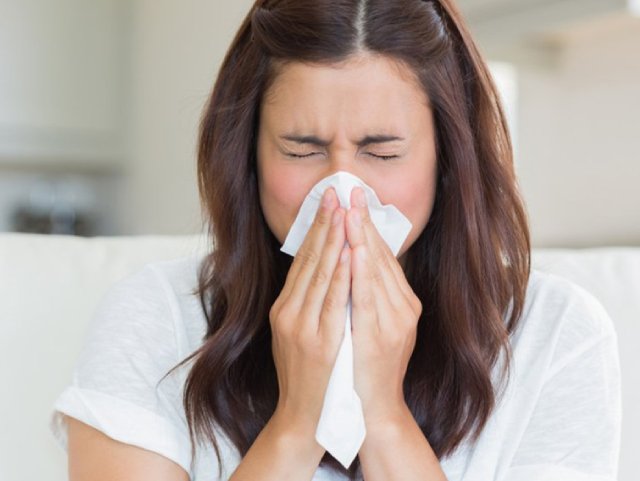It is often said, that allergies are the price we pay for modernity. In all modern families, at least one member suffers from at least one allergy, or will eventually develop allergies. This is attributed to heavy pollution, obsessively sanitized and carpeted environs, high stress lifestyles, indiscriminate immunization and greater number of infants brought up on formula, rather than breast-milk.
There is no “cure” for allergies. So the key lies in identifying the “triggers” and learning to either avoid them, or cope with them.
An allergy is an exaggerated response of our immune system to substances that are generally not harmful. Allergens are substances that irritate our immune system, thereby triggering an allergy. Potentially anything and everything we come in contact with, can act as an allergen. So this includes dust, mites, pollen, mold, animal hair and dander, food, medication, cosmetics, metals, sprays, dyes, plants, flowers, soft toys… The list is endless! Allergies can develop at any age, and tend to run in the family. Sadly, certain allergies like Asthma and Anaphylaxis, are life-threatening or debilitating.
Allergies are very common these days, and can either affect your eyes, your nose, your lungs, your skin or intestines.
When allergies affect your nose (Allergic Rhinitis or ‘Hay Fever’), you will sneeze non-stop and develop a stuffed, runny nose. If left untreated, in a couple of days, your throat starts to hurt and feel scratchy.
When allergies affect the airways of your lungs (Allergic Bronchitis or Asthma), you become wheezy and out of breath, suffer from uncontrollable hacking coughs, and have trouble breathing freely.
Eye allergies (Allergic Conjunctivitis or ‘Pink Eye’) leave you with itchy, watery, red eyes.
Skin allergies are in the form of intensely itchy hives (swollen welts on the skin). These can be triggered by stress, certain food and medication, or excessive sweating and heat. Eczemas are also an allergic skin reaction, where children develop red oozy scaly rashes on their face and limbs, which are itchy and distressing. Eczemas get worse in winters, or by wearing woolen clothes or artificial jewelry.
Intestinal allergies are specific to certain foods, like milk or gluten (in wheat, malt and barley). The symptoms include stomach cramps and colics, flatulence or diarrhea. Milk and wheat intolerance in a growing child is not only a nutritional challenge; but it also takes away from the joys of childhood, like eating ice cream and pastries. On the other hand, certain food like eggs and nuts can trigger skin allergies as well.
Anaphylaxis or “Allergic Shock” is a life-threatening allergic reaction that can affect a number of organs at the same time. It is usually triggered by certain food, drug or insect bites (usually bees, wasps and fire ants). Here a victim develops hives all over their body, along with choking, breathlessness, a swollen face and tongue and puffiness around the eyes. This condition is a medical emergency. If not treated immediately, it can result in death from choking and low blood pressure.
Why are allergies so common these days? Genetics play a role, as allergies run in families. But it is also hypothesized that modern day living, with heavy pollution, air-conditioning, frequent travels (exposing us to new and exotic allergens), obsessive avoidance of dirt and tap water, and wall to wall carpeting, are some of the reasons. For example, children who grow up in farms or developing countries, have fewer allergies than children growing up in developed countries. Breast-fed children have fewer allergies as breast milk has several precious antibodies which have a protective influence against allergies.
There is no cure for allergies in Allopathy or Alternative Medicine. The sooner one understands and accepts this fact, the easier it is to manage the problem. Antihistamines and decongestants provide relief, but are not curative. The key therefore, lies in identifying your allergens, and avoiding them. It is easy to avoid certain chemicals and cosmetics, whereas avoiding certain food or fabrics may not be so easy. Finally, if you are among the unlucky few who are allergic to pollen or dust or mold, which is invisible and all around us, then coping with your allergies can be a daily challenge.
Most people are able to identify their allergens without any testing. This is especially easy in the case of certain food or insect allergies. Avoiding the said allergen is all that is needed, and one can stay allergy-free, without the need for medication. There are vitamin fortified, Gluten-free food for the wheat-intolerant, while Lactose-intolerant individuals can depend on Yoghurt and Soy Milk for their nutritional needs.
If you are unable to identify a “trigger” or a pattern to your symptoms, then there are several tests that can help in detecting the offending allergen. These tests can be performed by physicians, dermatologists and immunologists.
Skin and eyelid allergies are usually identified by Patch Testing. In this test, diluted chemicals (“sensitizers”) loaded onto little aluminium discs are placed under a sticker on your back, and taken off 2 days later for a reading. This test is helpful in interpreting allergies, because you might not be allergic to all moisturizers and perfumes per se, but to specific ingredients like Parabens or Jasmine oil. In which case, you only need to avoid paraben containing cold creams or Jasmine containing perfumes.
To identify allergies caused by food, pollen, dust, mold, animal hair or insect parts, a Skin Prick Testing can be performed on your forearm or back. Small amounts of these antigens can be introduced into your skin by making very superficial pricks on your skin. Half an hour later, a reading is taken to identify the allergens which have caused an inflammatory reaction on your skin.
Blood allergy testing can also be done. These are quick and simple. They have certain advantages over skin testing, because these can be done irrespective of age, skin condition, medication, symptom, disease-activity and pregnancy. For infants and children, a single needle stick for allergy blood testing is often more gentle than making 30-40 skin pricks. However, blood allergy tests are more expensive.
How does one cope with allergies to dust, mites and pollen? These allergens are all around us, and very hard to eliminate from the environment. Certain lifestyle modifications can help. Regular dusting and vacuuming is helpful. Avoid carpets and wall hangings. Use dust-proof beddings, and get rid of soft toys and piled papers. Exposing mattresses, rugs and curtains to direct sunlight for more than 3 hours, kills all mites. Check your home for seepage issues. Mold growing in damp surfaces causes a lot of allergies every year, so maintain low air humidity by using air-conditioners and clean the filter often. Extractor fans in bathrooms and kitchens are useful in getting rid of steam and dampness. Use an air purifier to trap mold spores. If you suffer from pollen allergies, then avoid going out on windy days and use eye glasses when outdoors. If you have mold allergies, avoid drying damp clothes inside the house; and if you have pollen allergies, avoid drying damp clothes in open air. If you are allergic to cat or dog dander, then do not let them sleep on beds or furniture. Wipe pets down after long walks, and change their bedding weekly. Try a pet cleanser which removes allergens from clothes.
Despite your best efforts, if you are unable to overcome your allergies, then one might have to seriously consider drastic measures like change of job or residence, reupholstering your home, or getting rid of a beloved pet. If that is simply not an option, then speak to your Immunologist about therapies like desensitization or sublingual immunotherapies. Here a patient is gradually “vaccinated” by exposing them to progressively larger doses of the allergen in question. These treatments are your best bet for a “cure” but they are expensive, take time, do not work for everybody, and require long-term commitment. Gene therapies have been tried to treat allergies, and the results are exciting, but we are still a few years away from clinical application. Form local support groups, to share experiences and gain inspiration.




